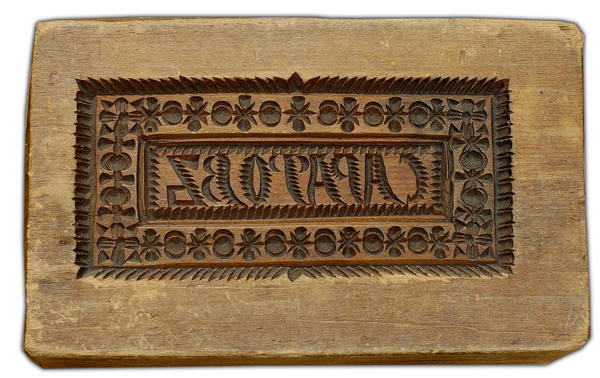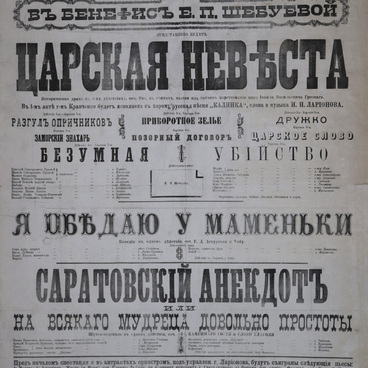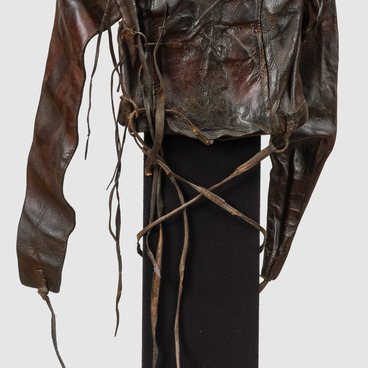The gingerbread board mold with the inscription ‘Saratov’ falls under the category of printed gingerbread boards. It was given to the history museum of the Saratov Scientific Archive Commission in 1912 by the curator of the museum, Bogdan Zaykovskiy. Zaykovskiy collected household items from the late 19th - early 20th centuries that characterize household life for the natives of the Saratov region. He acquired the ‘Saratov’ gingerbread board mold in 1912 at the Upper Saratov Market.
The inscription ‘Saratov’, cut so that it is inverse, is located in the center, in a recessed rectangular frame. It is executed in rhythmically repeating horizontal stripes. Circles, triangles, and shallow grooves cut around the perimeter compose a decorative pattern that was given a certain meaning in the past. For example, the circles symbolize the sun, and the grooves represent the fields. Despite the limited number of geometric shapes, the carver, by varying them, managed to achieve a great rhythmic expressiveness in the pattern.
Typically, gingerbread board molds were made from well-seasoned elm, pear, maple, or linden wood. The ‘Saratov’ gingerbread board mold was made of linden wood. Carving inscriptions required not only literacy on the part of the carver, but also the ability to perform inverse carving, so boards with inscriptions were especially valued. A wooden mold with a counter-relief pattern was superimposed on the dough, and using this an imprint was obtained. This method of applying a patterned impression was what determined the name of the gingerbread - ‘printed’.
Initially, gingerbread in Saratov Province was baked at home, and later in special establishments. In the Saratov chronicles compiled by members of the Saratov Scientific Archive Commission, a record from 1714 mentions the Saratov merchant Pyotr Fedorovich Kalashnikov, who ‘trades in the meat row, and in the building with the eatery and gingerbread craft…’. Homemade gingerbread was prepared in the family of the Saratov priest Gavriil Chernyshevskiy in the middle of the 19th century. Yekaterina Pypina, a relative of Chernyshevskiy, wrote in her memoirs: ‘Gavrila Ivanovich constantly fed us children with sweets: a gingerbread, the size of a sheet of paper, and semolina gingerbread’.
Gingerbread was sometimes the object of a game or dispute during fairs. Pyotr Boyev, a member of the Saratov Scientific Archive Commission, attested: ‘The gingerbread game existed in Saratov mainly on holidays and days when the market was open, and it consisted of grabbing a piece of gingerbread in a certain way and breaking it into three parts with one blow’. Dexterous and strong players could win 15-20 poods (a Russian unit of measurement corresponding to 16 kg) of gingerbread during the fair.
The inscription ‘Saratov’, cut so that it is inverse, is located in the center, in a recessed rectangular frame. It is executed in rhythmically repeating horizontal stripes. Circles, triangles, and shallow grooves cut around the perimeter compose a decorative pattern that was given a certain meaning in the past. For example, the circles symbolize the sun, and the grooves represent the fields. Despite the limited number of geometric shapes, the carver, by varying them, managed to achieve a great rhythmic expressiveness in the pattern.
Typically, gingerbread board molds were made from well-seasoned elm, pear, maple, or linden wood. The ‘Saratov’ gingerbread board mold was made of linden wood. Carving inscriptions required not only literacy on the part of the carver, but also the ability to perform inverse carving, so boards with inscriptions were especially valued. A wooden mold with a counter-relief pattern was superimposed on the dough, and using this an imprint was obtained. This method of applying a patterned impression was what determined the name of the gingerbread - ‘printed’.
Initially, gingerbread in Saratov Province was baked at home, and later in special establishments. In the Saratov chronicles compiled by members of the Saratov Scientific Archive Commission, a record from 1714 mentions the Saratov merchant Pyotr Fedorovich Kalashnikov, who ‘trades in the meat row, and in the building with the eatery and gingerbread craft…’. Homemade gingerbread was prepared in the family of the Saratov priest Gavriil Chernyshevskiy in the middle of the 19th century. Yekaterina Pypina, a relative of Chernyshevskiy, wrote in her memoirs: ‘Gavrila Ivanovich constantly fed us children with sweets: a gingerbread, the size of a sheet of paper, and semolina gingerbread’.
Gingerbread was sometimes the object of a game or dispute during fairs. Pyotr Boyev, a member of the Saratov Scientific Archive Commission, attested: ‘The gingerbread game existed in Saratov mainly on holidays and days when the market was open, and it consisted of grabbing a piece of gingerbread in a certain way and breaking it into three parts with one blow’. Dexterous and strong players could win 15-20 poods (a Russian unit of measurement corresponding to 16 kg) of gingerbread during the fair.



